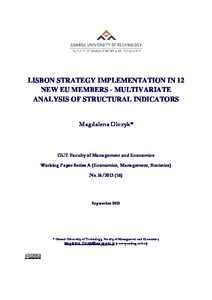Lisbon Strategy implementation in 12 new EU members – multivariate analysis of structural indicators
"The aim of this article is to identify diversity between the EU-15 and the New Members in their implementation of the Lisbon Strategy in the period 2000-2010. By analyzing a set of structural indicators, we aim to fill a gap in the literature: a lack of publications providing complex evaluatio...
| Main Author: | |
|---|---|
| Institution: | ETUI-European Trade Union Institute |
| Format: | TEXT |
| Language: | English |
| Published: |
Gdansk
2013
Gdansk University of Technology |
| Subjects: | |
| Online Access: | https://www.labourline.org/KENTIKA-19122729124919409019-Lisbon-Strategy-implementation.htm |
| Summary: | "The aim of this article is to identify diversity between the EU-15 and the New Members in their implementation of the Lisbon Strategy in the period 2000-2010. By analyzing a set of structural indicators, we aim to fill a gap in the literature: a lack of publications providing complex evaluation of the implementation of the Lisbon Strategy using measurable indicators. The results of our analyses confirm the hypothesis of a large gap between the EU-15 countries and the 12 New Members in key areas of the Lisbon Strategy. According to rankings given by our taxonomic analyses, a high level of the indicators selected is confirmed only for the EU-15 countries and only three New Members belong to a group presenting the average level of these indicators. This study demonstrates a need for a significant intensification of the EU cohesion policy, which is one of the main tools for achieving the Lisbon Strategy goals." |
|---|---|
| Physical Description: | 22 p. Digital |

